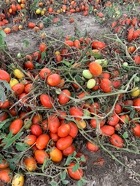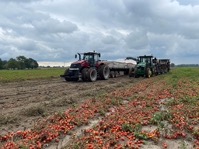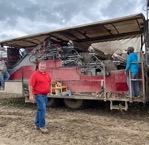Crop Tour Day 13 - Where do Tomatoes Come From, Where Do They Go?
By: Sophie Van den Borre, Dylan Van Nes, Jaime VanOoteghem & Danielle Vogels
This morning, we had an earlier start to our travels to try and beat the rain that was scheduled to hit us this afternoon. Thankfully, we missed the rain just in time! We visited Curt Utterback, who is the director of agriculture at Red Gold Tomatoes and grows his tomatoes for Red Gold as well. He showed us his tomato field and introduced us to the Red Gold Tomato company. Red Gold Tomatoes is a 4th generation family-owned operation based in Elwood, Indiana. They source tomatoes from three different states including Indiana, Ohio and Michigan.
Agronomy
While visiting one of Curt’s tomato fields, we had the opportunity to delve into some of the agronomic practices involved in growing tomatoes. Tomatoes are a high-value crop with high input costs.  They require extensive pesticide application throughout the season. Fungicide and insecticide applications are made on a schedule every 7-10 days, beginning at the green fruit stage. Fungicide applications may be made before green fruit if disease pressure is present. Curt, as well as all Red Gold growers, practice IPM. Red Gold requires a 3-year minimum rotation for all of their growers, but the longer the better. Red Gold provides scouting services as well as spray program recommendations for their growers. It was also interesting to learn about their pesticide resistance management techniques. Being in the United States, they have fewer limitations, making it easier to rotate modes of action. Resistance management and pesticide group rotations can be a struggle for tomato and horticulture crop growers in Ontario due to the limited number of products registered.
They require extensive pesticide application throughout the season. Fungicide and insecticide applications are made on a schedule every 7-10 days, beginning at the green fruit stage. Fungicide applications may be made before green fruit if disease pressure is present. Curt, as well as all Red Gold growers, practice IPM. Red Gold requires a 3-year minimum rotation for all of their growers, but the longer the better. Red Gold provides scouting services as well as spray program recommendations for their growers. It was also interesting to learn about their pesticide resistance management techniques. Being in the United States, they have fewer limitations, making it easier to rotate modes of action. Resistance management and pesticide group rotations can be a struggle for tomato and horticulture crop growers in Ontario due to the limited number of products registered.
The main insect Curt deals with is tomato fruit worms. There is a zero-tolerance policy for fruit worms found in processing. If fruit worms are found in a load of tomatoes, Red Gold will have the grower spray immediately. Luckily, they have access to insecticides with a 0 or 1-day PHI, allowing them to start harvest back up relatively quickly. Stink bugs can also be an issue however they are easily controlled by the weekly insecticide applications. The most prevalent disease tomato growers in the area deal with is bacterial spot. During our visit to the field, fruit affected by bacterial spot was very easy to find. Unlike in Ontario, Curt and other growers in the area did not see a high pressure of late blight this year. However, late blight is always a prominent threat when growing tomatoes.
When it comes to nutrition, potash is the name of the game! Curt applies a 1:1:4 ratio of NPK split applied at planting and side dressed. Curt was very knowledgeable about all aspects of tomato production, and we learned a lot in the short time we were there.
Red Gold Facility
Red Gold is not just a farm but also a tomato processing facility and trucking company. There are three locations where they process tomatoes: Elwood, IN, Orestes, IN, and Geneva, IN. Each factory is responsible for producing different products from the various grades of tomatoes.  For example, the lower-quality tomatoes are processed in Elwood for ketchup. Higher quality tomatoes would be processed at either of the other plants for products like peeled or sliced tomatoes. It only takes 12 minutes for a tomato to go from being unloaded to being canned. Red Gold will typically package these tomatoes in blank containers. This allows them to store the final products and label them for companies’ private labels at a later date. Some of their major labels include Walmart’s Great Value brand as well as Kroger’s private label brand. Overall, only 12% of the products they produce will get a Red Gold label. They also have a corporate office in Elwood for their full-time staff and a distribution centre in nearby Alexandria, IN. The distribution centre is over 1 million square feet in size.
For example, the lower-quality tomatoes are processed in Elwood for ketchup. Higher quality tomatoes would be processed at either of the other plants for products like peeled or sliced tomatoes. It only takes 12 minutes for a tomato to go from being unloaded to being canned. Red Gold will typically package these tomatoes in blank containers. This allows them to store the final products and label them for companies’ private labels at a later date. Some of their major labels include Walmart’s Great Value brand as well as Kroger’s private label brand. Overall, only 12% of the products they produce will get a Red Gold label. They also have a corporate office in Elwood for their full-time staff and a distribution centre in nearby Alexandria, IN. The distribution centre is over 1 million square feet in size.
Harvest schedules depend on the number of plants available for harvest, and each factory is assigned different loads based on quality. On average, they deliver approximately 18,000 loads a year, each load holding 25 US tons. They achieve this volume by sourcing approximately 10,000 acres from 35 growers.
 All tomato transplants are outsourced with the majority coming from a greenhouse in Georgia. Planting season typically starts May 5th, harvest starts August 11th and finishes up around October 12. Throughout November, they provide each grower with a performance review and then start planning for next year. Red Gold purchases paste from California during their winter months with no incoming tomatoes. By March, both the planning and seeding schedules are out, and the season restarts. While Red Gold rents their trailers out to growers, their clients are responsible for providing all equipment, delivery of transplants, and spraying programs. Red Gold provides sprayer recommendations for the growers, but it's up to the farmer whether or not they follow the plan. Overall, the Red Gold Tomato operation was very interesting and a new crop for many to learn about!
All tomato transplants are outsourced with the majority coming from a greenhouse in Georgia. Planting season typically starts May 5th, harvest starts August 11th and finishes up around October 12. Throughout November, they provide each grower with a performance review and then start planning for next year. Red Gold purchases paste from California during their winter months with no incoming tomatoes. By March, both the planning and seeding schedules are out, and the season restarts. While Red Gold rents their trailers out to growers, their clients are responsible for providing all equipment, delivery of transplants, and spraying programs. Red Gold provides sprayer recommendations for the growers, but it's up to the farmer whether or not they follow the plan. Overall, the Red Gold Tomato operation was very interesting and a new crop for many to learn about!
Midwest Tour Summary
 This trip has been a great opportunity to push us outside of our comfort zones and learn new things about agriculture outside of Ontario. We learned a wide variety of Midwest crops and management practices that we don’t do in Ontario. Cotton, rice, black walnuts, and irrigated corn were amongst the newest things we learned about! We also got to learn about American dairy, beef, swine production, and management as well. To wrap things up, the Midwest crop tour has been like what all OAC alumni have told us! It has made some of us think outside of the box and has given us new ideas to bring home.This has truly been an unforgettable experience, the OAC 2025 Bucks are thankful for this trip!
This trip has been a great opportunity to push us outside of our comfort zones and learn new things about agriculture outside of Ontario. We learned a wide variety of Midwest crops and management practices that we don’t do in Ontario. Cotton, rice, black walnuts, and irrigated corn were amongst the newest things we learned about! We also got to learn about American dairy, beef, swine production, and management as well. To wrap things up, the Midwest crop tour has been like what all OAC alumni have told us! It has made some of us think outside of the box and has given us new ideas to bring home.This has truly been an unforgettable experience, the OAC 2025 Bucks are thankful for this trip!

